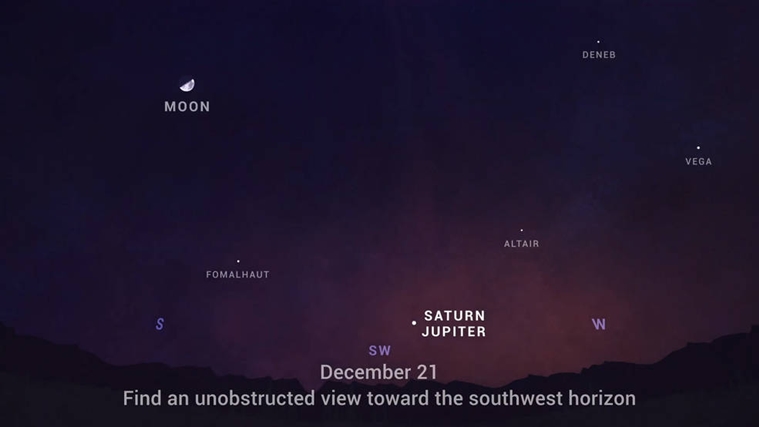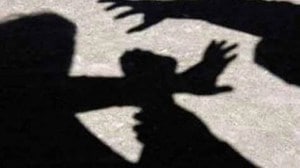Explained: What is the Great Conjunction of Saturn & Jupiter, also called the ‘Christmas Star’?
Jupiter-Saturn great conjunction: On December 21, almost all the viewers across the world will be able to see the two gas giants very close to each other, while they will still be hundreds of millions of miles apart in space.
 Saturn, top, and Jupiter, below, are seen after sunset from Shenandoah National Park, Sunday, Dec. 13, 2020, in Luray, Virginia, United Stated. (Credits: NASA/ Bill Ingalls)
Saturn, top, and Jupiter, below, are seen after sunset from Shenandoah National Park, Sunday, Dec. 13, 2020, in Luray, Virginia, United Stated. (Credits: NASA/ Bill Ingalls)Jupiter-Saturn great conjunction: After nearly 400 years, Saturn and Jupiter – the two largest planets in our solar system – will be brought closest in the night sky by an astronomical event called the “great conjunction” and popularly referred to as the “Christmas Star”. On December 21, almost all the viewers across the world will be able to see the two gas giants very close to each other, while they will still be hundreds of millions of miles apart in space.
The event will coincide with the winter solstice (shortest day of the year in terms of hours of sunlight received) in the Northern Hemisphere and summer solstice in the Southern Hemisphere.
So, what is the ‘Great Conjunction’?
A conjunction is not unique to Saturn and Jupiter however, it is the name given to any event where planets or asteroids appear to be very close together in the sky when viewed from the Earth. In June 2005 for instance, as a result of the “spectacular” conjunction, Mercury, Venus and Saturn appeared so close together in the sky that the patch of sky where the three planets were could be covered by a thumb. Astronomers use the word “great” for the conjunction of Jupiter and Saturn because of the planets’ sizes.
The “Great Conjunction” happens once in about 20 years because of the time each of the planets take to orbit around the Sun. Jupiter takes roughly 12 years to complete one lap around the Sun and Saturn takes 30 years (Saturn has a larger orbit and moves more slowly because it is not as strongly influenced by the Sun’s gravitational force as planets that are closer to the Sun).
As the two planets move along their orbits, every two decades, Jupiter catches up with Saturn resulting in what astronomers call the great conjunction.
 Credit: NASA/JPL-Caltech
Credit: NASA/JPL-Caltech
In a NASAScience Live episode, astronomer Henry Throop likened the planets’ respective orbits to runners on a race track. Therefore, every two decades Jupiter–which can be thought of as a fast runner on the inside track of a racecourse–will overtake Saturn.
This overtaking is what viewers on Earth will witness on the night of December 21, when the planets will appear aligned in the sky, while they will still be millions of miles apart in space. 📣 Follow Express Explained on Telegram
Why makes the conjunction rare this year?
While Jupiter and Saturn have been moving along on their orbits all throughout this year, since the beginning of December Jupiter has been moving closer to Saturn and on December 21, it will take over Saturn as it orbits around the Sun.
Jupiter and Saturn are bright planets and can be typically seen with the naked eye even from cities. But during a conjunction, they appear to be close to each other, which is what makes the event noteworthy.
This year, however, the event is rare because the planets will come the closest to each other in nearly four centuries, in what astronomer Henry Throop described is a result of a “rare alignment” of the planets.
He said that typically, every 20 years, when Jupiter overtakes Saturn, it passes it about a degree apart in the sky as a result of which they can be seen separated in the sky. But this year, because of the alignment between them, the planets will appear to be especially close to each other in the sky to viewers on Earth at about a tenth of a degree.
Further, this year, the alignment of Saturn and Jupiter will occur at night, which has not happened in over 800 years. It is because of the timing of this alignment that viewers from nearly all over the world can expect to see this event.
How can viewers spot the great conjunction?
Viewers across the world, except those in Antarctica where it is sunny all day at this time and those in areas where the sky is overcast, should be able to see the conjunction with the naked eye all month long. But on the night of December 21, the planets will be the closest and a tenth of a degree apart, which means the patch of the sky where the planets are can be covered with a pinkie finger at arm’s length.
NASA recommends that viewers should find a spot with an unobstructed view of the sky, such as a field or a park. Then, about 45 minutes to an hour after sunset, viewers should look towards the southwestern sky, where Jupiter will appear like a bright star and Saturn will be slightly fainter and will appear above Jupiter, to its left. After Jupiter overtakes Saturn, the planets will reverse their position.
As per NASA, the planets will either look like an elongated star, while some astronomers say that they will form a double planet.
- 01
- 02
- 03
- 04
- 05






































